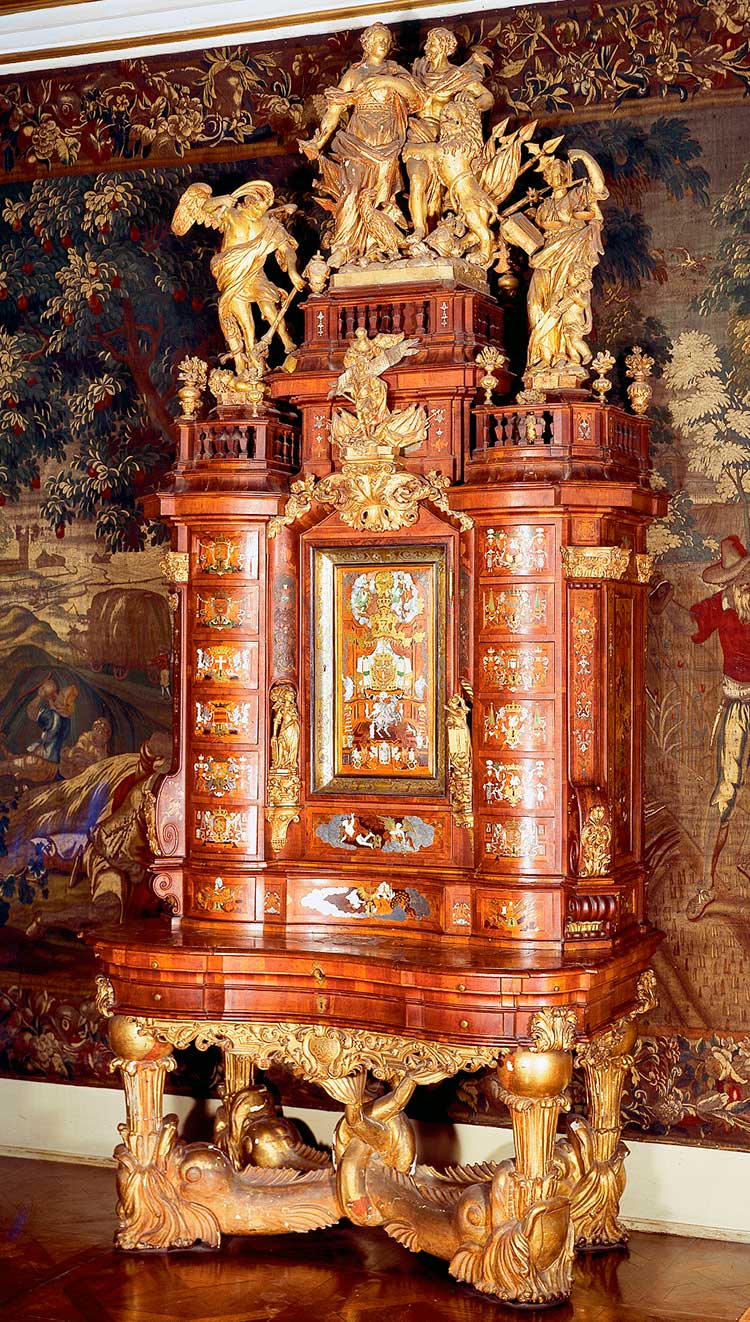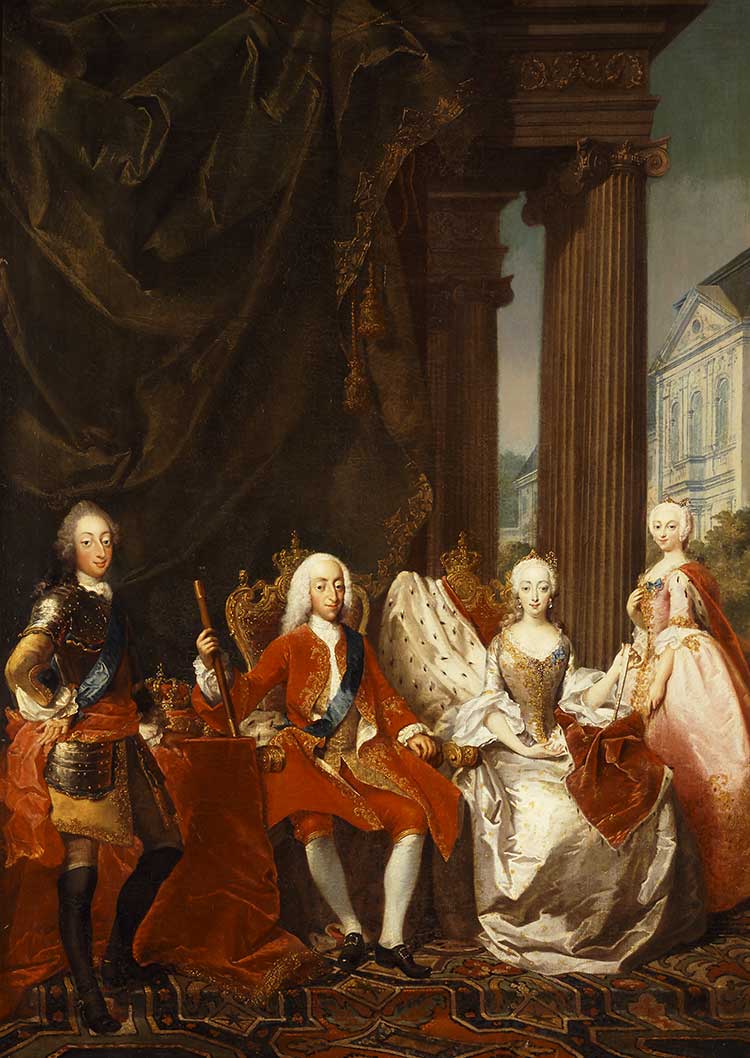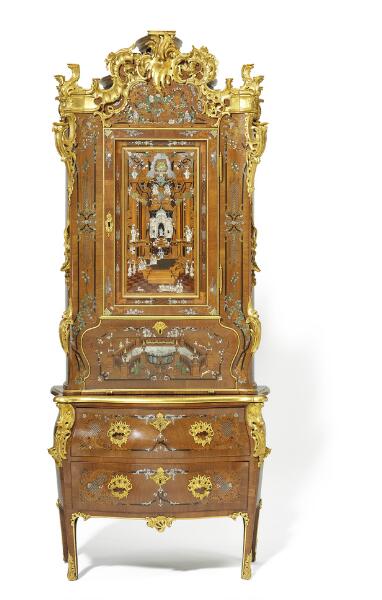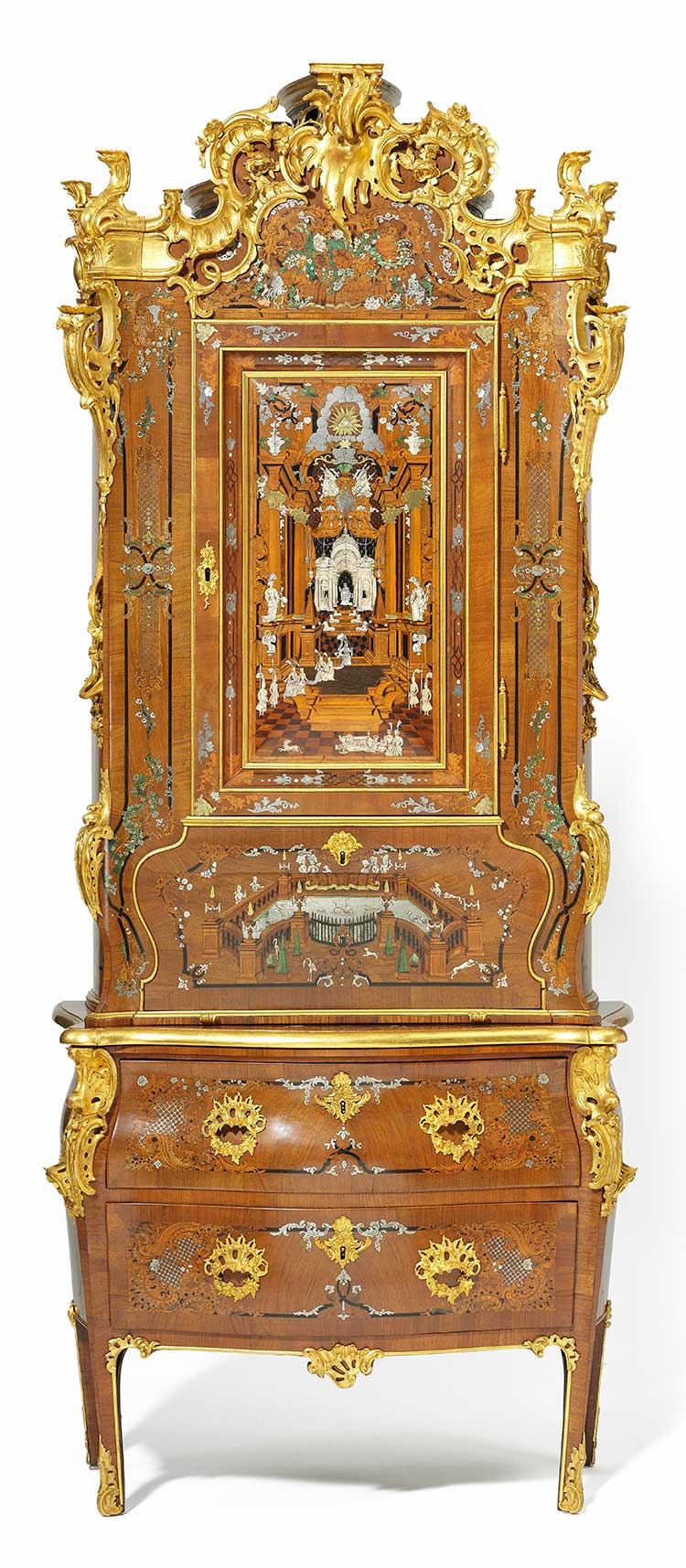Two Historical Bureau Cabinets
At Bruun Rasmussen, we can present two bureau cabinets of the finest quality from our upcoming Live Auction on 27 November. The story behind the cabinets goes all the way back to the time of absolute monarchy and some of Northern Europe’s most beautiful palaces. It is incredibly rare that antique furniture pieces of such fine quality are up for auction, so here is the chance to acquire irreplaceable cultural heritage of the highest standard.
One of the bureau cabinets was most likely made by the Royal Cabinetmaker Dietrich Schäffer for the Danish Dowager Queen Sophie Magdalene around 1750. It was commissioned for Hirschholm Palace, which at the time was considered "the Versailles of the North" and bears the joint monogram of King Christian VI (1699-1746, king 1730-1746) and his Queen Consort Sophie Magdalene of Brandenburg-Kulmbach (1700-1770).
The second bureau cabinet is from the same period, approx. 1730-40. It is a Chinese export bureau cabinet manufactured in China for the Danish market. That the bureau cabinet was intended for Danish customers can be seen in the European landscapes, which adorn the beautiful black and gilt lacquered bureau cabinet. Despite the significant difference in style of the two furniture pieces, they were both at the height of fashion in the middle of the 18th century.
A Tribute to the King and Love
When King Christian VI died in 1746 at the age of 46 at Hirschholm Palace just north of Copenhagen, the Dowager Queen settled permanently into the palace, which the couple had built together during the years 1730-44. The bureau cabinet was probably commissioned around that time and intended by the Dowager Queen as a tribute to the deceased monarch as well as the couple's great love for each other. On the central door of the bureau cabinet, the King, having already ascended to heaven, is seen standing in all his power and glory under a large triumphal arch surrounded by six lions – similar to the description of King Solomon's throne in the Old Testament. In actual life, the absolute monarch's lavish narwhal tusk throne (made between 1662-71) was surrounded by three large silver lions (made between 1665-70).
|
|
|
Queen Sophie Magdalene is seen ascending the stairs towards the King with an entourage of ladies-in-waiting, just as the Queen of Sheba went to King Solomon's Temple in Jerusalem (First Book of Kings, Chapter 10). Above the royal couple, a large baldachin is seen with their crowned joint monogram, documenting the royal provenance. The Holy Trinity in heaven is symbolized by the Eye of Providence, which casts its blessed glory upon the King while also signifying the divine right of the monarchy. On each side of the monarch, two allegorical figures can be seen that presumably represent art and architecture, which come together so wonderfully in this beautiful piece of furniture. In addition to the central scene, the impressive furniture piece is richly decorated with flower vines, wildlife and people depicted as being in total harmony with each other. Below the King is an idyllic section of the garden from the Hirschholm Palace with elegant ladies and gentlemen standing next to a pond where swans are swimming and dogs jump around. The beautiful and very vivid motifs are made with high artistic quality and great craftsmanship. The detailed inlays of different types of wood, brass, tin and bone appear essentially flawless. Inside the cabinet, there are numerous drawers and small shelves as well as an exclusive mirror cabinet covered with tortoiseshell. Mirror cabinets like these became popular among Europe's elite at the end of the 17th century, where the cabinets were used as exquisite furniture pieces and as part of interiors alongside mirrors on walls, ceilings and floors. Here, the elite could exhibit their collections of curiosities and show off their power and wealth to specially invited guests. |
The Royal Cabinetmaker Dietrich SchäfferThe style and level of craftsmanship of the royal Rococo bureau cabinet make it almost certain that the creator is the royal cabinetmaker Dietrich Schäffer. He was one of the 18th century's leading German cabinetmakers, specializing in the detailed Rococo style. He came to Denmark around 1731 in connection with the construction of the royal residence in Copenhagen, the first Christiansborg Palace (1733-40). Among other assignments, he was commissioned to create another bureau cabinet for Christian VI, which is now at Rosenborg Castle. There are certain similarities between the offered bureau cabinet and the piece at Rosenborg Castle – both in choice of motif, artistically and craftsmanship. This bureau cabinet is also a tribute to Christian VI, who in the central panel is surrounded by the national coat of arms as well as the individual coat of arms of his vast kingdom. Dietrich Schäffer was appointed Royal Cabinetmaker in Denmark in 1740 and collaborated for several decades with the Royal Building Masters of the royal palaces, Laurids de Thurah and Nicolai Eigtved. He created both exquisite furniture pieces with richly detailed carvings and joinery in the finest quality for the exclusive Rococo interiors that were fashionable at the time. |

|
Christian VI and Queen Sophie MagdaleneThe King was born into the House of Oldenburg, one of Europe's oldest royal families, and the Queen came from the German noble house of Brandenburg-Kulmbach. The marriage of the future King and Queen in 1721 was based on love, which was unusual for the time. While he was crown prince, Christian VI was allowed by his father, Frederick IV, to seek a bride on his own. The couple met at the court of the Electress of Saxony and Queen of Poland, Christiane Eberhardine of Brandenburg-Bayreuth, and fell in love. Both devout Christians, the royal couple remained highly devoted to each other throughout their marriage. As a celebration of this marriage, the Queen instituted the Ordre de l’Union Parfaite (order of the perfect union) in 1732. As King and Queen, Christian VI and Queen Sophie Magdalene ruled over a very large realm, stretching far beyond the borders of present-day Denmark. Under the couple’s rule, the area included the kingdoms of Denmark and Norway, the northern German duchies of Schleswig and Holstein, as well as the Faroe Islands, Iceland and Greenland. In addition, the kingdom also had colonies on Trankebar in India, the Gold Coast of Ghana and the Danish West Indies (the US Virgin Islands today). During their reign from 1730-1746, there were no major wars for the kingdom, which allowed for the construction of a series of lavish palaces and buildings, including Christiansborg Palace, the Hirschholm Palace and the Hermitage Hunting Lodge. Spending lavishly, the royal couple understood how to attract Europe's leading architects, carpenters and artists to their court and decorated their residences with paintings and furniture of the finest quality. As Sophie Magdalene wrote in her will “beautiful buildings honour one's country." Unfortunately, there is very little left of the furniture from these palaces since Christiansborg Palace burned in 1794 and Hirschholm Palace was demolished in 1810-12. Luckily, Christian VI's elaborate silver furniture was saved from the audience chamber at Christiansborg, and can today be seen in the Knight’s Hall at Rosenborg Castle. These furniture pieces, together with the two bureau cabinets of Dietrich Schäffer, offer a rare insight into the royal couple's time on the throne and their refined taste and appreciation of craftsmanship. |

|
From Hirschholm to Ravnholt
The Dowager Queen Sophie Magdalene remained at Hirschholm Palace until her death in 1770. It was for this residence that she commissioned the beautiful bureau cabinet created by Dietrich Schäffer. After her death, her grandson, the reigning King Christian VII, took over the palace, which was quickly occupied by his Queen Consort Caroline Mathilde of Great Britain and the Royal Physician Johan Friedrich Struensee, who had an affair together that resulted in the birth of Princess Louise Augusta in 1771. Following a coup in 1772, Struensee was executed and the Queen exiled, after which Hirschholm Palace was deserted until it was demolished in 1810-12.
According to the records passed down through the generations, the bureau cabinet was moved from Hirschholm Palace to Kokkedal Castle during the 19th century. From Kokkedal Castle, it was acquired by estate owner and politician Ove Sehestedt Juul (1830-82), who had inherited Ravnholt Manor on the island of Funen in 1861. The bureau cabinet has since then been passed down through the Sehestedt Juul family and was most recently acquired by a Danish private collector.
Chinese Export Bureau CabinetThe auction also includes a magnificent Chinese export bureau cabinet from approx. 1730-40 during Christian VI's reign. The bureau cabinet was manufactured for the Danish market. This can be seen from the detailed decorations that depict sceneries such as European hunting parties, card playing gentlemen and landscapes in a Chinese style. Throughout the many centuries where the Silk Road was the only trade link between China and the West, there were relatively few art objects that made it to Europe. But during the 16th century, the European shipping industry opened up new trade routes all over the world, and from the beginning of the 17th century, Great Britain, the Netherlands and Denmark-Norway established East Asiatic trading companies that brought home tea, porcelain, art, furniture, lacquerware and silk to the European market. The Danish Asia Company was established in 1730 to trade with China following the closure of The Danish East India Company. Two years later the company was granted a 40-year monopoly on the Danish trade with Asia. Especially the European royal families and noble houses were fond of using Chinese art, decorative art and furniture in their interiors. Lacquered objects were highly prized for their flawless finish and light-reflecting qualities. However, larger furniture pieces were still a rarity since they were expensive to ship to Europe. Nevertheless, the Danish kings ordered several exotic furniture pieces in China during the 18th and 19th centuries. Especially Christian VI and Queen Sophie Magdalene had a great penchant for Chinese furniture and had their palaces decorated with these exotic art objects to show off their power, wealth and knowledge of the world around them. Since the lacquer was admired as a precious and mysterious material and objects were made specifically for export, in forms and styles to suit Western tastes. The shape and design of this cabinet on sale has several similarities with “The Rococo Bureau Cabinet from Hirschholm Castle” which was sold at Bruun Rasmussen in 1997. It was made and labelled by the German-born cabinetmaker Mathias Ortmann (c. 1692 – 1757), who was a pioneer within the Rococo style in Denmark and his furniture is of such exquisite quality that it represents the finest within Northern European Rococo. The proportions of both bureau cabinets, with the framed, mirrored single door in the upper part as well as the rounded corners of the lower drawers and the placing of the legs have a familiar parallelism between them, however, the bureau cabinet up for auction has a Chinese influence. Other examples of rare and exceptional Chinese lacquer pieces with the distinctive fusion between Chinese and European art can be seen in the Royal Danish Collection. Including two identical cabinets made in Canton and shipped to Copenhagen aboard the China trader ‘Sleswig’ in 1737-1738. They were made according to British standards with an exotic wood type and decorated with Chinese gilt motifs on black lacquer. The top is adorned with three small gilded busts of Roman imperators in a Chinese interpretation. Immediately upon their arrival, the two bureau cabinets were taken into custody by the steward of the Royal Mansion (today the 'Prince's Mansion'). One bureau cabinet was sent to Hirschholm Castle in 1744, the other to Fredensborg Palace. Both bureau cabinets are currently located at Fredensborg Palace in the so-called Chinese dining room. It is uncertain whether the offered cabinet has stood in one of the Danish royal palaces, but it is a typical and very well-preserved example of the 18th century's interior style, where this type of furniture was highly sought after. |

View the opening hours of the preview
For further information, please contact:
Anders Fredsted: +45 8818 1142 · afr@bruun-rasmussen.dk

